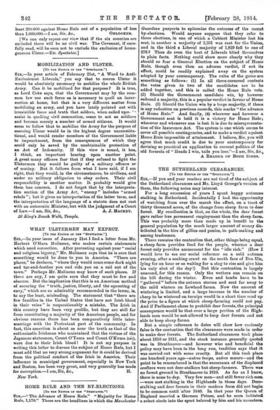THE SUTHERLAND CLEARANCES.
[To TEX EDITOR OD TIM ..SPBCDADOZ.n SIR,—If you and your readers are not tired of the subject of the Sutherland clearances and Mu Lloyd George's version of them, the following notes may interest.
For a long succession of years I spent happy autumns stalking in Sutherland. Incidentally I had the opportunity of watching from over the march the effect, on a tract of thirty thousand acres, of the change from sheep farm to deer forest. My recollection is that, on the whole, the deer forest gave rather less permanent employment than the sheep farm. This was probably more than made up in benefit to the general population by the much larger amount of money dis- tributed in the hire of gillies and ponies, in path-making and among tradesmen.
There remains the contention that, other things being equal, a sheep farm provides food for the people, whereas a deer forest only provides amusement for the "idle rich." (How I would love to see our social reformer on a cold autumn evening, after a soaking crawl on the north face of Ben Uie, lying for an hoer or so waiting for a stag to rise and give him his only shot of the day !) But this contention is largely unsound, for this reason. Only the wethers can remain on the bill during the winter. Ewes and Iambs have to be "gathered" before the autumn storms and sent far away to the mild winters on Lowland farms. Now the amount of wintering is limited, and a large increase in the number of sheep to be wintered on turnips would in a short time send up the price to a figure at which sheep-farming could not pay. And if Parliament chose to prohibit deer forests,the principal consequence would be that over a large portion of the High- lands men would be not allowed to keep deer forests and not able to keep sheep farms.
But a simple reference to dates will show bow curiously false is the contention that the clearances were made in order to make deer forests. The Sutherland clearances took place about 1810 or 1811, and the stock instance generally quoted was in Strathnaver—and however wise and beneficial the policy may have been in the long run, tradition says that it was carried out with some cruelty. But all this took place one hundred years ago—autres temps, autres mmura—and the point to be remembered is that the successors of the displaced orof tare were not deer-stalkers but sheep-farmers. There was no forest ground in Strathnaver in 1810. As far as I know, there is none to-day. Very few men—and still fewer rich men were met stalking in the Highlands in those &ye. Deer. stalking and deer forests in their modern form did not begin to be common until 'alter 1840. In that year the Queen of England married a German Prince, and he soon initiated a select circle into the sport beloved by him and his 'ancestors.
Landseer began to produce his famous pictures of red-deer. The idle rich of the period quickly discovered the charms of the Bighhmde- `"'Tis a very fine sport, So we'll follow the Court "— and stalking became as suddenly and vulgarly popular as the tango in later years.
There can be no doubt but that all this brought increased protection and security to the poor Highland deer and increased wealth to the poor Highland laird. Whether it did good to other people I refrain from discussing. I am, perhaps, a prejudiced witneaa. But what ie absolutely certain is that the increase of deer forests after 1840 or 1850 had nothing whatever to do with clearances in 1810. And to abuse the proprietor of the Reny forest on account of the Strathnaver clearances is just about on a par with demanding satisfaction from Mr. Lloyd George for the sins of Welsh attorneys of a hundred years ago.—I am, Sir, do, S. H. WHITBREAD. Boutkili Park, Biggleswacie.















































 Previous page
Previous page